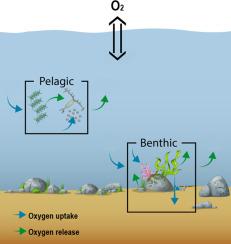Science of the Total Environment ( IF 9.8 ) Pub Date : 2021-09-11 , DOI: 10.1016/j.scitotenv.2021.150261 Peter A U Staehr 1 , Sanjina U Staehr 1 , Denise Tonetta 2 , Signe Høgslund 3 , Mette Møller Nielsen 4

|
We assessed the importance of boulder reefs to the oxygen dynamics of a shallow estuary during two growing seasons in 2017 and 2018. Using open-system diel oxygen measurements and benthic and pelagic incubations, we evaluated the relative contribution of pelagic and benthic habitats to the ecosystem metabolism along a depth gradient in two areas, with (Reef) and without (Bare) boulder reefs in the Limfjorden, Denmark. System integrated areal rates of gross primary production (GPP) and ecosystem respiration (ER) both increased with depth in both areas. Benthic contribution to system GPP and ER was highest at shallow depth where it represented 47 and 53% respectively. However, with increasing depth pelagic processes dominated GPP and ER (98 and 94%) even in the Reef area. Although the Reef area had higher biomass of auto- and heterotrophic organisms (macroalgae and macrofauna), benthic GPP was at similar level in both areas, due to a significant contribution from micro-phytobenthic organisms. The Reef area had lower sediment pools of organic matter, nitrogen and phosphorous and was slightly more oxygenated compared to the nearby Bare area. Extreme temperatures and higher levels of nutrients in 2018 caused a marked increase in benthic ER rates resulting in net heterotrophy (NEM = GPP − ER < 0) in 2018 compared to net autotrophy (NEM > 0) in 2017. Under current eutrophic conditions, boulder reefs do not contribute positively to the oxygen dynamics in the estuary. Reoccurring blooms of phytoplankton with high organic matter decomposition combined with high temperatures and dominance of fauna stimulate depletion of oxygen around the reefs. Significant improvements in water clarity are needed to regrow perennial macroalgae and induce net autotrophy. Under current turbid conditions, it is only recommended to establish boulder reefs in shallow (<3 m) parts of the estuary.
中文翻译:

巨石礁栖息地对浅口河口氧气动力学的贡献
我们在 2017 年和 2018 年的两个生长季节评估了巨石礁对浅口河口氧气动力学的重要性。使用开放系统的日照氧气测量以及底栖和中上层孵化,我们评估了远洋和底栖栖息地对生态系统的相对贡献丹麦 Limfjorden 有(礁)和无(裸)巨石礁的两个区域沿深度梯度的代谢。系统综合初级生产总值 (GPP) 和生态系统呼吸 (ER) 的面积率都随着这两个地区的深度而增加。对系统 GPP 和 ER 的底栖贡献在浅层处最高,分别为 47% 和 53%。然而,即使在珊瑚礁区域,随着深度的增加,远洋过程也主导了 GPP 和 ER(98% 和 94%)。尽管珊瑚礁区域的自养和异养生物(大型藻类和大型动物)的生物量较高,但由于微型植物底栖生物的显着贡献,这两个区域的底栖 GPP 处于相似水平。与附近的裸露区域相比,珊瑚礁区域的有机物、氮和磷沉积物含量较低,含氧量略高。与 2017 年的净自养(NEM > 0)相比,2018 年的极端温度和更高的营养水平导致底栖 ER 率显着增加,导致 2018 年的净异养(NEM = GPP − ER < 0)。在当前的富营养化条件下,巨石珊瑚礁对河口的氧气动态没有积极贡献。浮游植物大量繁殖,有机物分解率高,加上高温和动物群的优势,刺激了珊瑚礁周围的氧气消耗。需要显着改善水的透明度以重新生长多年生大型藻类并诱导净自养。在目前的浑浊条件下,只建议在河口浅水区(<3 m)建立巨石礁。



























 京公网安备 11010802027423号
京公网安备 11010802027423号